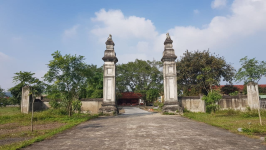
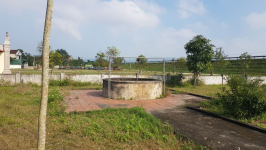
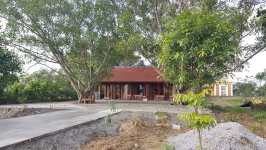
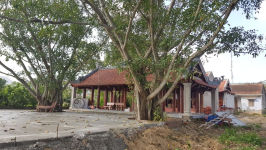
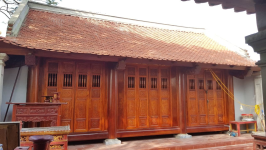
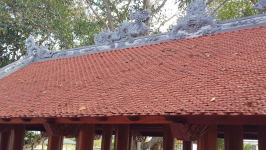
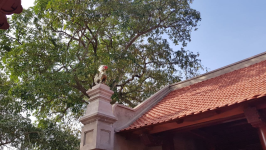
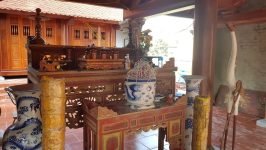
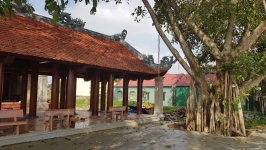
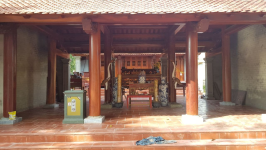
Camera tour
Price: Free
Time to visit a place: 120 phút
Open Time: 7:00 AM - Close Time: 6:00 PM
Address: Hung Khanh Village, Hung Nguyen District, Nghe An Province
KING LE TEMPLE
King Le temple was built in Trieu Khau area, near the foot of Lam Thanh mountain, where Lam Son insurgents built a base against the Minh invaders in the territory of Loc Dien village, Van Vien canton, now known as Hung Khanh commune, district Hung Nguyen, Nghe An province. The relic is a place where the people pay tribute and commemorate the great merits of King Le Thai To and the Later Le dynasty in repelling invaders, building and developing the country.
In 1418, Le Loi proclaimed himself Binh Dinh Vuong and waved the flag of rebellion against the Minh army in Lam Son, Thanh Hoa. From Lam Son, at the end of 1424, Le Loi pulled his army into Nghe An to make a foothold. From here, the forces of the insurgents developed strongly, successively won many victories, especially in the battle against Nghe An citadel after 02 years of building up momentum for the insurgents to attack Dong Quan citadel, gain complete victory, expel the Minh army from the country.
After 10 years of suffering all hardships to plot great things, in 1428, the country was cleared of invasion, Le Loi ascended the throne and established the Later Le dynasty which was the most prosperous dynasty in Vietnam's feudal history. King Le Thai To had reigned for 06 years. After the death of King Le Thai To, in order to remember the merits of the person who had merits to make the Later Le dynasty, the authority and people built King Le temple in the former Trieu Khau area.
Experiencing changes in history, King Le was combined to worship two more characters Le Khoi and Trinh Y Trai. Chieu Trung Vuong Le Khoi's name was Le Khoi, posthumous name was Vu Muc from Lam Son village, Thuy Nguyen district, Thanh Hoa province. He was the nephew who called Le Loi as uncle, used to carry a bow with Le Loi to fight the enemy from the first day in his hometown in Lam Son and made many merits. When King Le Nhan Tong ascended the throne, he was assigned the position of Nhap Noi Thieu Uy, taking care of Nghe An land. During the time in Nghe An, he tried his best to let people reclaim the alluvial land of Lam River at the foot of Thanh mountain and established many villages such as Quang Du, Nghia Liet, Trieu Khau... With the merits of contributing to the country, after his death, he was ordained the title of Nhap Noi Tu Khong, Binh Chuong Su, given the posthumous name as Vu Muc Cong, and built a temple and stele right at the place where he died at the foot of Long Ngam mountain. After the temple was moved to Trieu Khau commune, where he was stationed, the people often called it Vu Muc temple. In 1954, a great flood toppled the temple, so the people brought the statue and worshiping items to combine at King Le temple.
King Le temple is also a place to worship Trinh Y Nguyen Phi, born in Quan Lai commune, Loi Duong district, Thanh Hoa province, who was the wife of Le Loi. She used to follow her husband from the beginning of career in Thanh Hoa until entering Nghe An, she sacrificed her life for the great cause of her husband. After her death, the people of Trieu Khau area set up a shrine to worship her. During the anti-American resistance war, the temple was destroyed by bombs, the people carried the throne and her tablet to combine workshiping at King Le temple.
King Le temple was built in the 15th century on a high and open land, about 1ha wide with a fairly large scale including three-door gates, lower hall, middle hall, upper hall and two left and right houses. Due to natural disasters and floods, the items of llower hall, middle hall, left and right houses were washed away and damaged, only upper hall was remained. Due to the requirement to build a dike to prevent floods, the previous three-door gate was also filled, and was newly built by the people in 1994.
Currently, King Le temple is located close to the foot of the dike, and still retains the upper hall (back-space) with 03 compartments with an area of 40m2, which is a relic item that was restored from the old materials of the temple after being washed away and damaged by a flood in 1978. Later, the authority and people contributed, built more workshiping hall, three-door gate serving the sacrifices.
Every year, on 22 August of the lunar calender, people in the area gather at the temple to celebrate the death of King Le Thai To. This day has became a traditional festival at the monument.
With outstanding historical values, King Le temple was ranked a national historical and cultural relic by Ministry of Culture and Information in Decision No. 423/QD-VH, dated 20 February 1997.
Distance: 9.53 km
Distance: 9.70 km
Distance: 9.72 km
Distance: 9.76 km
Distance: 9.95 km
Distance: 10 km
Distance: 10.14 km
Distance: 10.39 km
Distance: 10.40 km
Distance: 10.63 km
Distance: 10.67 km
Distance: 10.89 km
Distance: 2.81 km
Distance: 9.26 km
Distance: 9.41 km
Distance: 9.44 km
Distance: 9.93 km
Distance: 9.98 km
Distance: 10.38 km
Distance: 10.89 km
Distance: 10.91 km
Distance: 10.96 km
Distance: 11 km
Distance: 11.10 km
Distance: 11.13 km
Distance: 11.20 km
Distance: 11.23 km
Distance: 11.26 km
Distance: 11.37 km
Distance: 11.38 km
Distance: 0 m
Distance: 1.82 km
Distance: 2.11 km
Distance: 2.82 km
Distance: 3.64 km
Distance: 3.64 km
Distance: 6.39 km
Distance: 7.91 km
Distance: 7.91 km
Distance: 8.96 km
Distance: 9.03 km
Distance: 9.05 km
Distance: 9.13 km
Distance: 9.46 km
Distance: 9.86 km
Distance: 9.90 km
Distance: 9.91 km
Distance: 9.85 km
Distance: 10.07 km
Distance: 10.42 km
Distance: 10.45 km
Distance: 10.49 km
Distance: 10.68 km
Distance: 10.72 km
Distance: 10.80 km
Distance: 10.87 km
Distance: 10.97 km
Distance: 11.12 km
Distance: 11.24 km
Distance: 11.30 km
Distance: 11.30 km
Distance: 11.32 km
Distance: 11.32 km
Distance: 11.45 km
Distance: 11.49 km



0
No Comment!